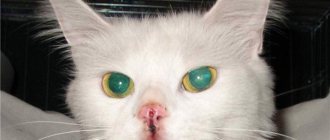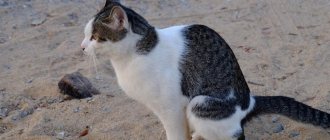8103Administration
The appearance of sores on a cat’s neck brings a lot of worry and trouble to the owner. And it’s not sweet for the animal itself. Often the sores are accompanied by itching and pain. The cat scratches them, which further aggravates the situation. If you notice a sore in the form of a rash, sores, pimples, etc., you must definitely find out the cause and treat your pet.
Some pathologies can cause serious damage to the health of your home. This article will help you understand what causes neck sores in cats and how to deal with them. The most common situations are discussed below.
© shutterstock
Fleas
Blood-sucking parasites (aka fleas) are quite capable of causing sores under the fur on a cat’s neck, and this is one of the most common causes. Insects, whose favorite place is the neck area, bite the animal, which causes severe itching. The cat begins to itch and scratches the bites, turning them into wounds. The situation will only get worse if action is not taken.
With dirty claws, an animal can introduce an infection into the sore, which can lead to purulent inflammation. In addition, the scratched area will attract even more fleas, and they are known to be carriers of all kinds of infection. To avoid serious complications, you need to fight the parasites and only then begin treatment. Today there are a huge number of different flea remedies available :
- special collars;
- pills;
- shampoos;
- sprays;
- powders;
- drops on the withers, etc.
When no trace of parasites remains, the wounds are treated with peroxide, iodine or other antiseptic. If there are purulent formations, you cannot do without the help of a veterinarian and more serious medications.
© shutterstock
Stages
The stages of acne can be distinguished. There are four in total:
During stage 3, the follicle ruptures and pus comes out. At this stage, there is a danger of serious infections, since existing wounds are open and protective functions are weakened. The main thing is to avoid furunculosis. With this disease, numerous ulcers begin to appear, which will be very difficult to remove.
Remember that blackheads do not mean that the kitten has acne. These could be nits, fleas, bites or ringworm.
Subcutaneous mite
When cats have itchy sores on their necks, but no fleas are found, perhaps another parasite is to blame - a tick. It lives under the skin, so it is impossible to notice. But often there will be trouble. Subcutaneous mites can cause serious pain. Such, for example, as sarcoptic mange, demodex and others.
To find out what kind of pathology develops in the cat’s body, causing sores on the neck, you need to take the animal to the clinic, where they will take blood for analysis and conduct other examinations. Treatment is selected by the doctor depending on the identified disease.
Most often, cats are prescribed Ivermek in tablets or injections for intramuscular administration. Also, in the treatment of neck sores caused by ticks, drugs such as “Frontline” and “Stronghold” are often used, which are available in veterinary pharmacies and are not expensive.
An animal affected by parasites must be isolated from other pets, if any, and, if possible, from people (especially children). The hair on the skin where the sore has formed is cut off.
Treat the bare surface with sulfur or aversectin ointment . Prescriptions may also include the medicine “Advocate” and drops “Amit Forte”. The cat's habitat, as well as all objects with which it comes into contact, must be thoroughly disinfected.
Infectious skin diseases
Itching in an animal can be caused by an infection that has penetrated into the thickness of the skin through scratches, small wounds, or flea bites. Local inflammation causes the cat to itch furiously, but bacterial infections can be treated well. Veterinarians advise using sulfur ointment or Juglone powder externally. These drugs cope equally well with dermatomycosis and bacterial infections. Systemic treatment may require antibiotics, but these medications should only be given to your pet as directed by a doctor.
Juglone powder, dissolved in an oil base, was rubbed into the skin for ringworm behind the cat's ear. After a few days, the lesion shrank, and after a week of use it disappeared completely. Juglone is a black walnut extract that is used in America to treat parasitic diseases. The drug has a bactericidal, sedative, antifungal, antiprotozoal and immunomodulatory effect. According to expert reviews, the product copes well with skin problems in animals. We have only recently begun to treat dermatoses with this medicine, and the drug is difficult to find on the market.
Infectious skin lesions in cats are secondary and are not transmitted to humans. Most often, people are the source of infection for cats.
Allergy
If your cat's hair falls out on its neck and sores appear, it could be an allergy. Most often it is caused by food products, but not only. Among the irritants are :
- dust;
- fleas;
- household chemicals;
- mold;
- hygiene products.
© shutterstock
Sores initially appear on the neck, but then can “migrate” to other areas of the head: chin, ears, forehead. Over time, they become covered with crusts, which the animal scratches due to severe itching and then licks. As a result, the sores turn into wet, bleeding, very painful wounds. They bring severe suffering to the cat, and its quality of life is significantly reduced.
The main method of combating such diseases is eliminating the allergen. However, first you need to identify it. It is unlikely that you will be able to do this on your own. It is necessary to go to a veterinary clinic, get tested, and undergo other examinations. When the cause is determined, the cat is prescribed a course of treatment with antihistamines.
If it turns out that fleas (or rather, their saliva) cause an animal’s allergies and a sore on the neck, it is recommended to treat the pet’s fur with insecticide-based products. Also, drugs to cleanse the body are usually prescribed as treatment. Experts advise bathing your cat using special shampoos that relieve itching from sores.
Getting rid of itching is not the solution
First of all, owners strive to alleviate the condition of their pet. If you apply standard allergy treatment, the symptoms will return after a while. It is necessary to use local remedies that dry the wounds and alleviate the condition, but this is not the main focus. Therefore, the main task is to find the real reason for what is happening. Only after diagnosis can effective treatment be prescribed.
Any skin disease takes a long time to cure, so don’t be discouraged if there are no quick results. The most important thing is your attention and the support of an experienced doctor.
Miliary dermatitis
When the disease affects the neck area and manifests itself as scatterings of small pimples, miliary dermatitis is first suspected, which is always a consequence of other pathologies. It is even more expedient to talk about it, not as a separate sore, but as a symptom of another ailment. The doctor will tell you exactly what pathology caused this type of dermatitis after the diagnosis. It is impossible to do this on your own.
© shutterstock
Often a rash on the neck becomes a manifestation of a food allergy. Among the causes are also subcutaneous mites. Treatment will depend on what exactly caused the skin sore. By the way, rashes can appear not only on the cat’s neck, but also on other parts of the body.
Factors that cause acne in cats
The exact causes of acne in cats are unknown. Possible factors include:
- insufficient care. It is difficult to lick a cat’s chin on your own, and oxidized sebaceous plugs clog the skin pores;
- skin diseases;
- fatty foods;
- hormonal imbalances;
- pathologies of the liver or gastrointestinal tract;
- stress;
- decreased immune defense of the body.
Abnormalities in the development of the sebaceous glands or hair follicles cause excessive production of sebum (secret from the sebaceous glands) and the appearance of acne. What they look like can be seen in the photo of acne in cats.
Bacterial dermatitis
There is also a type of dermatitis called bacterial. It can also cause ulcers on the neck. As the name implies, it is provoked by pathogenic bacteria. Often other diseases become the impetus for development. In particular, allergies, demodicosis, pathologies of the endocrine system.
The pain is very bad. It manifests itself as itchy wounds, the area of which steadily expands without treatment. As a result, a huge bleeding spot is observed on the skin. In advanced stages, bacterial dermatitis can cause an abscess, and the formation of fistulas and nodes is also possible.
Moreover, they are much more difficult to cure than an ordinary ulcer. If you find sores on the neck, you should immediately show your cat to a doctor in order to start therapy on time and avoid serious consequences. Self-medication of bacterial dermatitis is strongly discouraged. Moreover, there is no single scheme. It is selected individually.
Acne worsening
Black and white inflamed acne, which bursts and turns into ulcers, is lubricated with antibiotic gels. Veterinarians usually prescribe Bactroban or Mupirocin. The preparations are applied once a day in a thin layer and care is taken that the cat does not lick off the residue.
If your pet constantly scratches his acne, the wounds are washed with an antiseptic diluted with water and then treated with iodine or brilliant green. Rub zinc ointment into the dried crusts. The drug accelerates healing and relieves itching.
An animal whose black spots have turned into inflamed ulcers has its claws trimmed. The cat will not be able to scratch the rashes and introduce a secondary infection into the burst boils. The pet should not be allowed outside or on the balcony; the sun is contraindicated for it.
In severe cases, the veterinarian suggests castration. In cats, after surgery, the hormonal levels normalize, and the rashes gradually disappear.
Ringworm
Ringworm is a fairly common disease in animals. In cats it is usually more complicated than in other pets. It can be located on the neck, head or paws. At the beginning of the development of the disease, hair falls off from the affected area of the skin. The exposed dermis wrinkles, turns red, and becomes covered with rough yellowish-brown scales.
© shutterstock
If you look closely, you can see a white coating on the sore . This is the fungus that causes shingles. The affected skin is very itchy, the cat constantly scratches the sores on the neck, thereby spreading the fungus further. Ringworm spreads quickly and, if your pet is not treated, soon the poor thing's entire body will be covered with one continuous scab. The animal may die.
Therapy for such a disease requires complex treatment. If possible, it is recommended to shave the cat's head so that the lichen does not spread (after all, the fur may be infected). The animal is treated using :
- ointments (“Nystatin”, “Griseofulvin”), etc.;
- oral medications (“Ketoconazole”, “Griseofulvin”), the dosage of which is determined by the doctor depending on the severity of the disease.
The room in which a cat infected with ringworm lives must be disinfected. Daily wet cleaning is mandatory. It is better to isolate the animal, and burn the things it touched if disinfection is not applicable to them. Such precautions are necessary to ensure that the sore does not attach itself to one of the family members.
Features of operations to remove such tumors
Such formations, first of all, should not be enucleated, that is, only the tumor itself should not be removed. According to the rules of oncological surgery, they must be removed, taking into account the surrounding tissues, taking into account their anatomical location, taking into account the blood and lymph circulation in this area. This means that it is better to contact a qualified oncologist or surgeon to ensure that this formation is excised correctly and to reduce the likelihood of relapse and further spread of the tumor.
Surgical intervention for tumors in animals is not considered in terms of simple surgical excision alone. Such important points are assessed as, firstly, whether this excision will improve the quality of life of the animal, and secondly, whether the animal will continue to live adequately, whether it will be mobile after the operation and how long the rehabilitation period will be. All these points are taken into account by the oncologist surgeon.
If he considers the intervention appropriate, if there is a possibility that this intervention will be successful, it is carried out. If this intervention is crippling, if it does not improve the quality of life of the animal, or if the prognosis is unfavorable, then there is no question of surgery.
Susceptibility to disease
There is no pattern here. There are no specific statistics that the disease most often occurs in such and such a breed, at such and such an age, with such and such a color. Absolutely any cat can get sick, regardless of breed and age.
Here you can make a small remark: in hairless cats () acne is still much more common than in their more fluffy counterparts, and the inflammatory process is much more severe.
In addition, it was noticed that castrated and sterilized cats practically do not have acne, but since isolated cases have been recorded, it cannot be said that the operation will save the animal from such dermatosis.
Hereditary factors also play a major role in the formation of acne.










